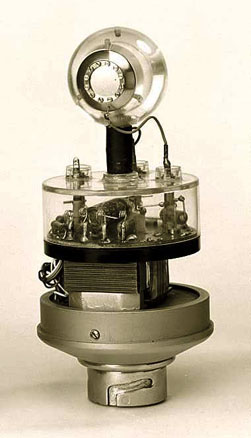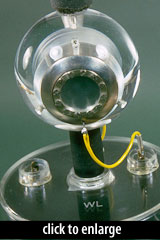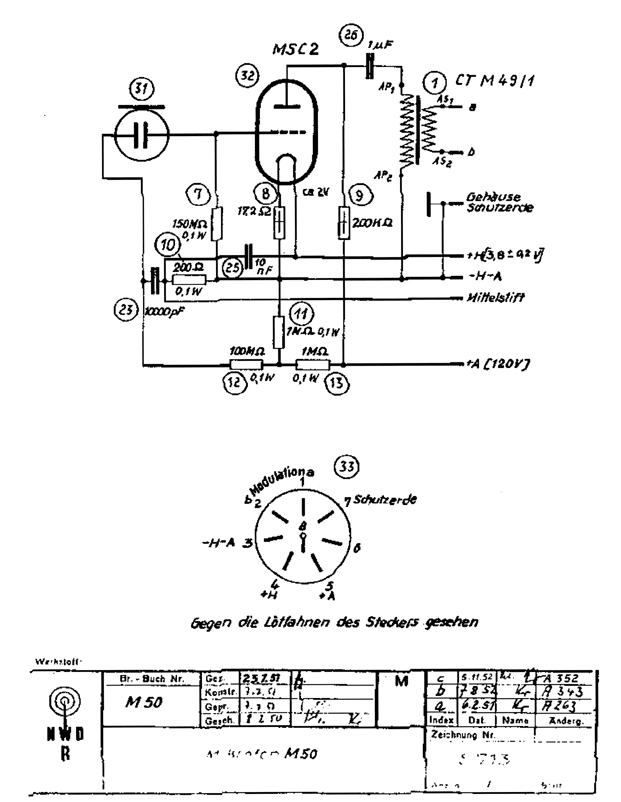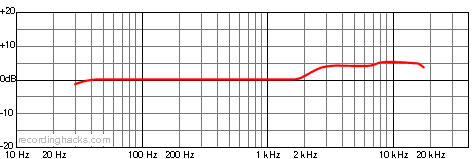 Neumann M 50
Neumann M 50
Omnidirectional Tube Condenser Microphone
Neumann’s M 50 was an omnidirectional tube mic based on the chassis and amplifier of the multipattern M 49. The primary difference between the two was the innovative capsule used in the M 50.
The M50 used a small omnidirectional transducer mounted on a 4cm-diameter acrylic sphere, such that the diaphragm of the capsule lay flush with the face of the sphere. Because sound flows differently around a sphere than around other surfaces, the microphone’s frequency response is altered by this capsule construction. Specifically, the M50 had a smoothly rising frequency response that looks nearly like a high-shelf EQ set to +5dB above 2500Hz.
Neumann
With a diffuse sound field, this results in an almost linear frequency response from 40 [Hz] to 15000 [Hz].
The value of this response characteristic is beautifully explained by Stephen Paul in his classic survey of vintage mics:
Stephen Paul
High frequencies roll off as the square of the reciprocal of the distance from the sound source due to frictional effects. This means that the viscosity of the air is sufficient to dissipate sound energy in the form of heat, and as there is less power in the treble range, it suffers the most from this effect. Therefore, when a mic is hung high above an orchestra in the auditorium, a boost in the response above 5 kHz is desirable. Even today, these microphones still make some of the most wonderful orchestral recordings in the world.
Related to the effect of the rising frequency response is the directional characteristic of the microphone. Simply put, the mic — although technically speaking still an “omnidirectional” — is more directional at higher frequencies.
Neumann
The unique feature of the microphone is its high frequency directivity, similar to that of a pressure gradient type, combined with the linear response at low frequencies, well-known for pressure microphones.
Neumann changed components in the M50 several times during its production run from 1951–1971, although not all of the changes were indicated by a model-number designation. The following details are taken from Martin Schneider’s AES presentation on spherical omni microphones (see sidebar link):
- M 50, 1951: The first commercial release used a Hiller MSC2 tube and a PVC-diaphragm KK50 capsule. According to Neumann’s Martin Schneider, the PVC material was not well suited to the “extreme mechanical tension” required.
- M 50a, 1952: the ‘a’ version indicated a capsule change, from KK50 PVC to an aluminum-diaphragm KK53.
- 1954: the MSC2 tube was replaced with a Telefunken AC701. (This tube/capsule combination was reproduced in the KM53, a tube omni pencil mic.)
- M 50b, 1963: “a negligible change, of resistor power ratings.”
- 1965: The KK53 capsule was replaced with the Mylar-diaphragm KK83.
- M 50c, 1965: the “filament topology” of the amplifier circuit was changed, lowering the self-noise by 4dB.
Anselm Roessler
This microphone was, however, extraordinarily difficult to produe and the rejection rate was enormous, so production was halted in 1971.
The concept of altering an omnidirectional condenser transducer’s frequency response by embedding it into a Perspex sphere originated with the NWDR (Nordwestdeutscher Rundfunk) Laboratory, which was Northwest German Broadcast’s research institute, under the direction of Herbert Großkopf.
Neumann has since released the TLM50, a transformerless interpretation of the spherical-omni-capsule concept.
The M 49 and M 50 shared a case and grille design — the grill employs Neumann’s traditional 3-layer metal mesh with a slanted, flattened face. The only visible exterior difference between the two mics is the color of the “jewel” above the Neumann logo on the body. On the M 50, the bead is white. On the M 49, the bead is red.
 The amplifier circuitry for the M49 and M50 is “virtually identical,” according to Neumann historian Anselm Roessler, although the M49 employed a dual-diaphragm capsule with remote pattern-switching circuitry.
The amplifier circuitry for the M49 and M50 is “virtually identical,” according to Neumann historian Anselm Roessler, although the M49 employed a dual-diaphragm capsule with remote pattern-switching circuitry.
On both mics, the amplifier circuit board is shockmounted on a solid rubber disc. Both mic capsules are shockmounted (via rubber inserts) onto the acrylic cover above the circuit board.
Neumann has created several newer microphones based on the technologies pioneered in the M 50. See the sidebar links to the M150 Tube and TLM 50 microphones.
Summary of distinguishing characteristics of Neumann’s spherical-capsule microphones
| M 50 | TLM 50 | M 150 Tube | |
| Amplifier type | tube (AC701) | FET | tube (6111) |
| Capsule | KK83 | AK 33 TI | K 33 TI |
| Diaphragm | Mylar | Titanium | Titanium |
| Output type | transformer | transistor | transistor |
| Grille | sloped | rounded | sloped |
| |||
The Neumann M 50 is also known as: M50.
The mic was released in 1951.
Specifications
| Frequency Response - OmnidirectionalClick Graph to Compare! |
|---|
 |
| Pickup Patterns | Pads & Filters |
|---|---|
|
Omnidirectional
(15 mV/Pa; 40 - 16,000 Hz) |
|
| Capsule Dimensions | Impedance | SPL/Noise |
|---|---|---|
| Diaphragm diameter: 12mm |
n/a | Max SPL: 114 dB |
| Weight | Length | Max Diameter | Interface(s) |
|---|---|---|---|
| 800g (28.22oz) | 163mm (6.42'') | 80mm (3.15'') |
|
| Power Specifications |
|---|
|
Did we get anything wrong on this page? Please let us know!






